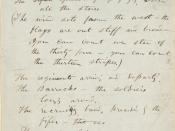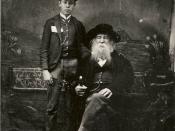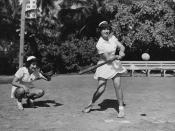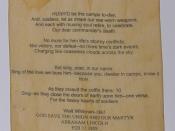Wave resemblance in Walt Whitman's "If I Had the Choice" Although not rhythmically or metrically consistent throughout, Walt Whitman's poem "If I Had the Choice" is very consistent in its attempt to resemble the characteristics, specifically the waves, of the sea; whether read, heard, or seen, the poem's adaptation to a wave's nature is clearly evident. Whitman's use of repeated, but not uniform, rhythm in the poem exposes the "up and down" nature of waves, while the sudden, drastic change in rhythm helps depict the crashing of a wave. The metrical variation in the poem similarly attributes to the resemblance of a wave, for it goes hand in hand with the length of each line, giving the poem the physical characteristics of a wave.
While the there is no metrical consistency throughout the poem (probably done because no two waves are identically alike), there is a noticeable pattern and consistency in the rhythm of the poem.
The consecutive use of iambs in the first five lines of the poem help to not only emphasize the steady motion of the sea, but more importantly to give the poem a sense of the "up and down" motion of the waves in the sea; the pattern of unstressed/stressed/unstressed/stressed syllables in every line is very similar to the up and down undulation of a wave. The shift from the iambic rhythm in lines one through five to a "loud," sudden spondee in line six clearly depicts the image of a wave crashing. The spondaic rhythm (stress/stress) of the first two words in line six, "These, these," is an unexpected, drastic change from the prior unstressed/stressed pattern. Similar to the crashing of a wave, this change was drastic, and quick; it does not last long, hence the reason for the poem's quick return to an iambic rhythm. The poem's last three lines are once again consistently iambic; they are back to the quiet, pacific motion of waves in the sea.
Just as the height of a wave affects the power of a wave, the meter of this poem affects it's rhythm. Although there is no specific pattern for the number of feet per line in this poem, the meter is still greatly significant. When broken up iambically, the number of feet increase steadily from line one to four, until we reach line five, the longest (10 feet) line. The length of line five is significantly important in portraying the nature of waves; it is representative of the amplitude of a wave before it is about to crash. Line five is ten feet long because it is followed by line six, the line in which there was a sudden rhythmical change, which portrayed the crashing of the wave. Once it crashes, the waves return to their prior size, just as the following lines of the poem go back to having the same range of feet as they did before line five.
The alternating number of feet per line also allow the poem's structure to resemble a wave; no two waves are similar in frequency (height) or amplitude (width), just as no two sentences of this poem are identical in length. As the lines approach the middle of the poem, they get longer, and then begin decreasing in size after they reached the longest point, line five. Since line five, the middle of the poem, is the longest line, when held sideways, this line is representative of the middle of a wave, it's highest point right before it crashes.
By using rhythm and meter skillfully, this poem is successful in imitating the rhythm of the sea, and the "meter" of the waves in the sea. In doing this, Whitman makes a very distinctive point; rhythm and meter affect each other, just as the height of a wave affects it's crash. This relationship is evident whether one reads, sees or hears this poem.





